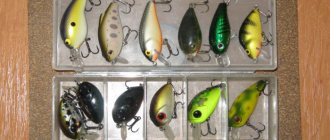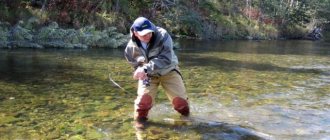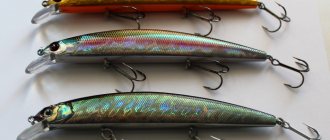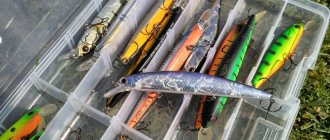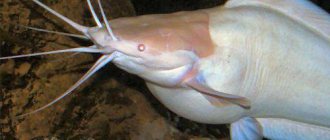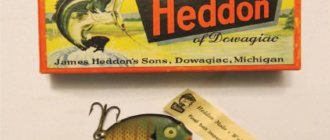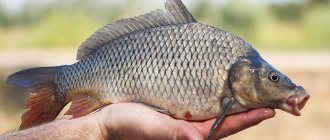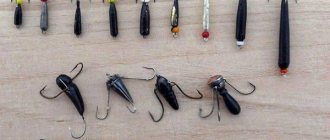Crankbaits, or simply crankbaits, are baits with a difficult fate. They are either wildly popular or fall out of favor. The Americans generally awarded these fat men the epithet “idiot baits.” The point here is in apparent primitiveness and simplicity, but this, by the way, is the main advantage. Crank is an extremely interesting bait that has repeatedly proven its high efficiency.
Cranks are, perhaps, the first bait that beginners use. Indeed, these wobblers are perfectly suited for mastering the basics of fishing science. However, this fact does not mean that experienced anglers should refuse them.
Crinkles for every taste
Cranks: varieties
Based on their shape, crankbaits can be divided into 3 types.
- Feta. “Fat” translated from English sounds like “fat man,” which is quite consistent with the appearance of these baits. “Well-fed” shorties, almost round in diameter, are characterized by “crazy” play. Floating and sinking, with a large and small blade, they all cope equally well even with strong currents. Another advantage of “fetics” is high flight performance;
- Flats. They differ in the average frequency of oscillations. Good for calm waters. A flat body makes it possible to perform different types of animation, including jerking;
- Sheds. The most numerous variety of cranks. "Shade" is translated as "herring", but they are not always similar in shape. Although this is by no means an obstacle to effective fishing in different conditions.
As for models, there are many of them. Let's look at the most popular ones.
- Tsuribito Super Crank. A universal soldier with a length of 6 cm. Ideal for catching pike in fast-moving bays and chub in calm rivers. Working depth - 1-1.5 m. Combines a variety of colors, excellent flight capabilities and reasonable cost;
- Yo-zuri 3D Flat Crank. This noise wobbler is familiar to many. Used for catching pike, perch, chub. Length - 5.5 cm. Working depth - 1.2 meters;
- Yo-zuri Hardcore Surface Crank. The surface pike crank is designed to work in swamps, shallow water shallows, and bays. One of the best of its kind. Working depth - 0.3 m. There are other versions with working depths up to 1.5 m;
- Rapala Clackin Crank. New noise crank. It features an interesting game and high-quality durable coating. Working depth - 1.2 m;
- Jackall Chubby. This crank has rightfully earned the title of “legend”. Impressive when fishing for chub on small rivers. Working depth - 30 cm. There are modifications that dive up to 1.5 m;
- Strike Pro Chubby Crank. Best price/quality ratio. Length - 6 cm. Working depth - 30 cm. Optimal for catching pike and perch;
- Samba 100 from Liberty. Universal wobbler of elongated shape. Great animation. Provides the opportunity to fish with both straight-line wiring and twitching;
- Tsuribito Crank 50. A well-proven classic. Plays realistically and flies far. Working depth varies from 0.2 to 1.5 m.
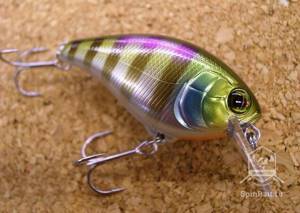
General classification of wobblers
There are no wobblers designed specifically for catching perch. However, wobblers designed, for example, for catching pike, chub, and trout, are successfully used to catch “minke whales.”
Homemade wooden wobbler
The following materials are used to manufacture products:
- plastic;
- tree;
- glass and other materials.
As a rule, the product has 2–3 special tees. Today there are a large variety of baits on the market that are very popular. A large assortment makes even an experienced fisherman think. How do baits differ from each other? To date, there is no clear classification of baits. The main differences are:
- buoyancy;
- form.
The length of the product varies from 3 to 20 centimeters. In addition, the products are available in different colors.
According to the degree of buoyancy
Lures have varying degrees of buoyancy:
- Fast Sinking . Fast-sinking category.
- Slow Sinking – category of slowly sinking.
- Suspending – category of neutral buoyancy. Products in this category can remain in the water column and also hover at a certain depth.
- Fast Floating . Category of fast swimmers. In this case, it is necessary to use fast wiring.
- Super Slow Sinking – category of slow sinking boats.
- Sinking is a category of drowning people.
- Slow floating. Slow pop-up category. It is recommended to use slow wiring.
- Floating – category of floating. Characterized by shallow immersion. Easily floats to the surface.
Buoyancy affects the behavior of the model in the vertical horizon. Hence. Buoyancy affects wiring.
By the presence of blades
The blades are a structural element of the bait. He has an impact on the game. Today, various blades are used.
Today, stepped and straight structural elements are very popular. Let's take a closer look at each form:
- Stepped. An original paddle that can significantly improve your game. The spatula is made from an ordinary wooden block or plastic. The unique shape gives the wobbler a unique trajectory of movement.
- Straight. The spatula can be made from various materials (steel, wood, plastic). The straight blade is easy to install. In addition, you can adjust the angle from the horizon line. The straight blade makes the game more sweeping.
- Curved. A curved blade is difficult to install. The angle cannot be adjusted. Various materials can be used to make a curved blade. A special soldering iron is used to bend the curved blade.
Color matters
The color of the bait is sometimes crucial. If the water is cloudy, then the cranks should be bright, if transparent, they should be more natural.
In muddy water and poor lighting, a predator will pay attention to a noisy and “juicy” wobbler, while in daylight, the tapping of the balls and the “screaming” shade can be frightening.
Cranks of contrasting colors are considered to be very effective. Combinations of red and white, yellow and black, green and yellow, gold and black are very lucky.
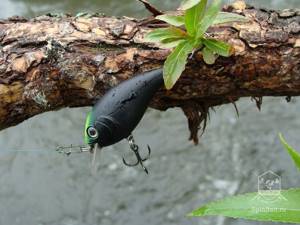
Recommendations for catching a predator
Since all cranks for pike perch or pike have certain design features, their use is determined by different nuances. The catchability of the wobbler will depend on the skill of the spinning rod, his ability to crank so that the fish does not have any doubts about its realism. The choice of fishing rod is also important. These baits weigh no more than 20 g, so the spinning test must be within these limits. In order to be able to control the behavior of the bait as much as possible in the water, you need to ideally choose a spinning rod, since cranks and wobblers are the most sensitive to this imbalance.
Moreover, there is a large selection of these baits, which does not allow us to identify uniform rules for all fishing conditions and types of wobblers. Any bait is designed for specific conditions of use.
Still, you need to listen to the advice of fishermen:
- When catching a predator in the current, if there is an extraneous background noise, it is advisable to use baits with sound chambers. When retrieving, they make noises that spread over a long distance, which is sure to interest the pike. Moreover, it is best to choose cranks with one ball in the chamber.
- The performance of the wobbler will depend on the material, length, body shape, etc. Therefore, any model requires a careful approach. Any design is created to suit the play of different parts of the body: torso, tail and head. When fishing for pike perch, it is advisable to choose baits with low-frequency vibrations. Moreover, some crankbaits begin to start during any wiring and show their advantages, and some wobblers need to be animated, using all your skills and experience.
- Catching pike with a spinning rod involves using sinking cranks. The game can be ensured by constantly winding the cord and tightening the spinning rod, this creates the necessary game. If the fish behaves inactively, then during the retrieve it is necessary to make pauses during which the predator attacks the crank. The main task of the fisherman is to create a uniform and slow retrieve.
- Some spinners believe that when using a crank, the most effective is a uniform retrieve. However, this does not mean at all that other types of wiring will be unpromising. The spinner has a large field for experimentation, and the angler can use any wiring he likes, in particular, his own “branded” one. It is important that the bait has a stable and realistic action. This can only be achieved through the right choice.
- The color of the bait is selected taking into account certain fishing conditions. If the reservoir is transparent and clean, then it is not necessary to select a bright crank. It may not only not interest the pike, but will also scare it away. At the same time, in muddy water it is advisable to use bright colors that can attract fish from afar. Moreover, it is necessary to take into account gloomy or sunny weather; this also makes additional adjustments. In other words, a certain amount of experience is required, which begins to come with time.
Crank fishing: equipment
In terms of equipment, crank fishing is not at all similar to jig fishing. Hypersensitivity is not required here. The ability to cast sailbaits is important. Build: medium-fast. The spinning rod must have excellent throwing characteristics and great power.
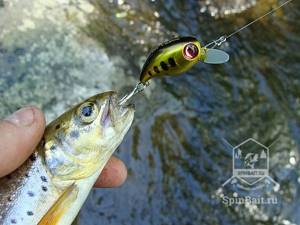
Trout caught on a crank
Which cord should you choose? The question is not as simple as it might seem. If the terrain is poorly studied, then give preference to a sensitive braided cord. Do you want to throw a wobbler to the maximum possible depth? Take thin braid.
Those for whom natural wiring is important should trust monofilament. Today, by the way, a worthy alternative has appeared that does not involve a painful choice - fluorocarbon.
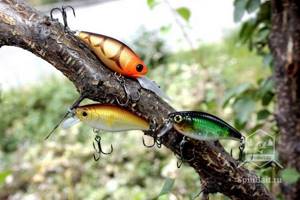
A low-profile baitcasting reel will allow you to cast bait over long distances. In addition, it is reliable and durable. If there is none, then you can get by with the usual inertia-free one.
Wiring technique
Wiring can be done in different ways. Uniform wiring is recognized as the most effective. If you turn to specialized literature on this issue, you may come across diametrically opposed opinions. Some sources advise wiring as slowly as possible, others, on the contrary, as quickly as possible. Indeed, it is difficult to find a definite answer. It is necessary to act according to the situation. Depending on the crank model, its working depth, fish activity and fishing conditions. Often the fish is responsive to uniform fishing with acceleration.
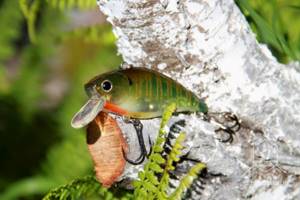
If the fish is not too active, then fishing with stops—“stop and go”—increases the chances of success. Pauses can vary in duration (from 1 to 3 seconds). The behavior of the bait largely depends on the model.
Some cranks can be twitched. Thus, the flat shape of flat cranks creates a powerful vibration when turning, which encourages the predator to attack. The wobblers Butcher from Salmo, Flat-Crenk from Yo-Zuri and HPFCrank from OSP are considered proven in this regard.
If we talk about the direction of the wiring, then opinions are divided. The first claim that only with the flow, the second - only across. The most correct option is to be guided by personal preferences and, of course, convenience.
Thus, crank fishing is a process that requires some experience. Each bait needs to be chosen in a place and time. But the result promises to exceed all your expectations. So don’t deprive these “good-natured fat men” of your attention—they will definitely come in handy!
Wobblers for perch - making the right choice
Perch has always been a treasured catch for the avid fisherman. Perch has fairly good strength characteristics and always actively resists when fishing. Well, of course, we must not forget that smoked perch is a kind of delicacy, especially if the specimens are quite large.
Perch is a fairly common fish. It can be found in almost any body of water. It is unpretentious and can live calmly in those reservoirs where the water is not so rich in oxygen.
In addition, perch calmly gets along with the ubiquitous sleeper, which is increasingly spreading in water bodies and eating the eggs of other fish. Basically, the prickly predator prefers to stand at the bottom.
Most fishermen catch perch using baits such as spinners, jigs, wobblers, poppers, and so on. In short, when fishing you can use almost your entire fishing arsenal. It is difficult to choose a rig or bait that cannot be used to catch perch.
But today I would like to talk about such a universal bait as a wobbler for perch. We will try to give advice on the right choice, and at the end of the article we will make a rating of the 10 best wobblers for perch.
When choosing a wobbler, you need to adhere to some rules, which in this article we will try to convey as correctly as possible.
First you need to make some parameters for selecting a wobbler:
- By time of year;
- By illumination;
- By water transparency.
First of all, the choice is greatly influenced by the time of year, or more precisely, the parking places during different periods. For example, in the spring, when the ice has just melted, perch does not strive to leave their wintering places as quickly as possible. There is no point in looking for it near the shore and in shallow water, but the holes will be the most promising.
Based on this, wobblers should be chosen with greater depth. As a rule, the depth is written on the box, so you should pay attention to this when purchasing. Over time, the angler himself will be able to calmly determine the approximate depth at which the wobbler will go, based on the size of the shovel.
Important! You need to try to select wobblers so that they go near the bottom, but do not scratch along it.
In the summer, the fish return to their usual stopping places and catching perch with wobblers becomes even more interesting due to the increase in its activity. Prefers to be near some irregularities in the bottom topography. For example, perch always liked dumps and fishing on them was very productive.
Searching along the coastal grass and reeds will also bear fruit. The striped predator often hides there, waiting for a lost fish. Special attention can be paid to the overgrown bottom. Often the perch hides near the bottom in this grass and waits for the fisherman to move the bait over the layer of grass.
In the fall, the perch returns back to its winter resting places, just as in the spring it will be practically useless to catch it in the coastal line.
There is a clear classification of wobblers. According to the degree of buoyancy, the following types of wobblers are distinguished:
- drowning;
- slowly sinking;
- sinking quickly;
- wobblers with neutral buoyancy (suspenders);
- weakly floating;
- floating.
Based on the presence of a blade, wobblers are divided into bladed and bladeless. Bladed ones include:
- Minou (has a purulent form);
- Shad (for fast current);
- Crank (with a wide, flattened body);
- Fat (drop-shaped).
Bladeless are divided into:
- superficial;
- medium depth.
Surface have the following types:
- Popper (for fly fishing, the body is covered with hairs or feathers);
- Walker (for fishing in overgrown areas);
- Chagger (makes squelching sounds, is a type of popper);
- Crowler (has a “waddling” game).
Medium depth wobblers:
- rattlin (flat, with a rattle inside);
- darter (has excellent hydrodynamics);
- jerk bait (for jerking at shallow depths).
Illumination
During the day, perch's wobbler tastes can change greatly. In the morning, when the sun is just beginning to show its first rays, bright baits will be in good demand among the predator, since after the night it needs to be awakened in some way.
The same will happen at sunset, when the sun slowly disappears behind the horizon. Bright baits such as orange, yellow and red will clearly appeal to the perch.
During the day, in sunny weather, such bright baits should be abandoned. In the sun they will be too noticeable for the perch and such colors will only scare away the fish. The efficiency of fishing in this case will decrease.
Water clarity
The main thing in a wobbler is not its color, but the vibrations and vibrations that it creates. Color does not play the most important role when perch fishing, but it must be taken into account.
In muddy water, visibility can be almost zero and in order to attract perch, bright colors that will be visible from great distances are suitable.
In clear water, the “sailor” can notice the bait from afar; if it is too bright, he simply will not want to attack it. In clear water, the natural colors of fish that nature has painted them with will work best: silver mixed with dark.
Choosing the right bait size for perch
Perch is a rather small fish when compared with other inhabitants of reservoirs. Therefore, baits should also be smaller than, for example, when fishing for pike. The standard size of a wobbler for perch is considered to be a bait measuring up to 7-8 centimeters.
Wobblers of 9-10 centimeters are used to catch trophy humpback whales. Moreover, the fisherman must know for sure that they are in the water area, so as not to rinse such large baits just like that. The tactics for catching perch are quite simple. In the pits, the most important thing is to feel for a striped flock and start throwing it around.
You need to experiment with wiring; if the fisherman knows that the “striped fighter” is standing on the point, but does not take it, you need to try changing the wiring.
For example, move away from standard uniform wiring to more daring twitching, which, as a rule, can tempt even the most passive perch to bite. And now you can move on to the fun part, namely the selection of wobblers for perch.
But before compiling a kind of top wobblers, I would like to say that there is no such wobbler that will catch always and everywhere. For each situation you need to select your own baits, try with colors and patterns. Source: “iarybak.ru; ranoutrom.com"
